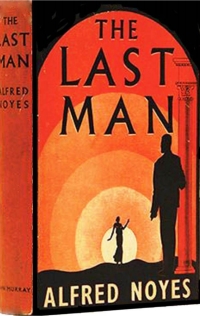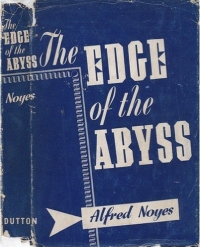So many novels just
mark Time rather than condensing it, or, ideally, eliminating it. Eventually
The Last Man falls into this trap, largely because of the expositional chunks,
which -- even though they have an intellectual validity of their own -- become
sermons in search of a believer rather than servants of the story. Plot-points
are postponed, action denied. You can skip them, of course, and any
dramatization would ignore them except for the choicest bon mots.
In the age of such
awful weapons as the Russian SS 18 Satan 5 ICBM or the American B61-12 surgical
nuke, all of this late Modern fantasy might seem romantic. Birds, animals,
insects, plants all remain alive, undisturbed, as if the human heart alone
is/was susceptible to the kill power of the mysterious death ray. Thus the
weapon is as much figurative as it is meant to be real, an author's conceit in
the game of pretend. Bodies do not decompose; somehow they calcify, as if
embalmed by the invisible wave that stops the human heart, and only the human
heart. Then the calcification turns to ash and the bodies disappear into Nature
with no messy inbetweens.
The writing is very
good, fluid and easy, just like Noyes' ballads. Yet it's utterly out-of-step
with today's plain narratives which regress towards the pictographic rather
than advance towards rhetoric.
For nearly half a
century, the literature and art of western civilization had succumbed (partly
out of intellectual snobbery) to the subtle propaganda of the new
atheism.
In Rome, Mark Adams
goes to the Keats House where -- of course -- he settles down in the library to
read some English poetry. Why not? The solitude of the end of the world is the
poet's solitude, the longing for aloneness and the rapture of the eternal. In a
sense, Adams is pursuing his Muse; so for Noyes, the author, the narrative
becomes an art essay framed in fantasy. It's both basic science fiction (which
evolved from the science essay) and high culture discourse. Yes, it goes on a
bit much at times, a sermon rather than a story, and Noyes interrupts the
action too often for the contemporary reader who wants action and only action.
Perhaps it's the last gasp of classicism, where civilization falls to science,
and language becomes labelling rather then rhetoric. In this sense, the poet
Noyes is "The Last Man."
Eventually Adams finds
Evelyn's address in the telephone book and when he breaks into her apartment,
finds a message: look for me in Ravello. What a trip! Thomas Cook could not
have planned it better, even with a discount for the end of the world.
And then, unseen,
he saw her, standing on the parapet before him. She was gazing out to sea, with
her light print dress fluttering round her like a flower in the wind from the
south....
When "Adam" catches up
to "Eve" the novel is halfway done. When the villain Mardok catches up to the
young lovers, the narrative is 70% and the rest of the action decides their
fate. Evelyn owes her survival to Mardok, "a man who never let his right hand
know what his left is doing", a man of unknown nationality and origin. His
unflattering description is pure semi-tone:
The brutal mouth
and fanatical eyes of Mardok belonged to a type that fifty years ago would
never have commanded admiration, except perhaps in the
underworld.
Knowing that the world
was doomed at 3 pm G.M.T. he arranged to have Evelyn with him in a diving bell
exploring the ocean floor just off Capri. Of course the diving bell is fitted
out more like a penthouse than a submarine, and has two diving suits for their
escape after the death wave attack; at the time, Mardok apparently drowns, but
Evelyn, a strong swimmer, survives. This is what happens when you attempt some
"loathsome" Freudian analysis on a young woman in a diving bell, it seems. You
might think of Mardok as an expression of the prevailing totalitarianism,
although his pedigree is a more Miltonic form of evil than the extreme
nationalism of the 20th century dictator. In fact, Noyes inserts some
apologetic business to suggest that Mussolini was a friend of Britain, and was
forced by France into an unfortunate alliance with Hitler. Well, Noyes loved
Italy, no question.
The Last Man: a
beautifully written yet bizarre novel -- which, of course, makes it all the
more attractive to the literary archaeologists among us. Poetic rather than
scientific, religious rather than secular, and, strangely, static rather than
mobile even though the hero never stays still. The landscape is locked in
nostalgia, well rid of the meddlesome human race and its idiotic politics. Is
it science fiction? Not really, although it fits into the tradition of
alternate world novels developed by the SF genre.
When it comes to
Doomsday, 'The Last Man' is a poet and a neo-classicist, not some fellow in a
Hugo Boss lab coat.
© LR
November 2016
The Last Man at
Amazon:
USA
|
Canada
| UK
*Check out LR's
OUTLAW
ACADEMIC »»
or LR's novel
RADIO
BRAZIL »»
|

